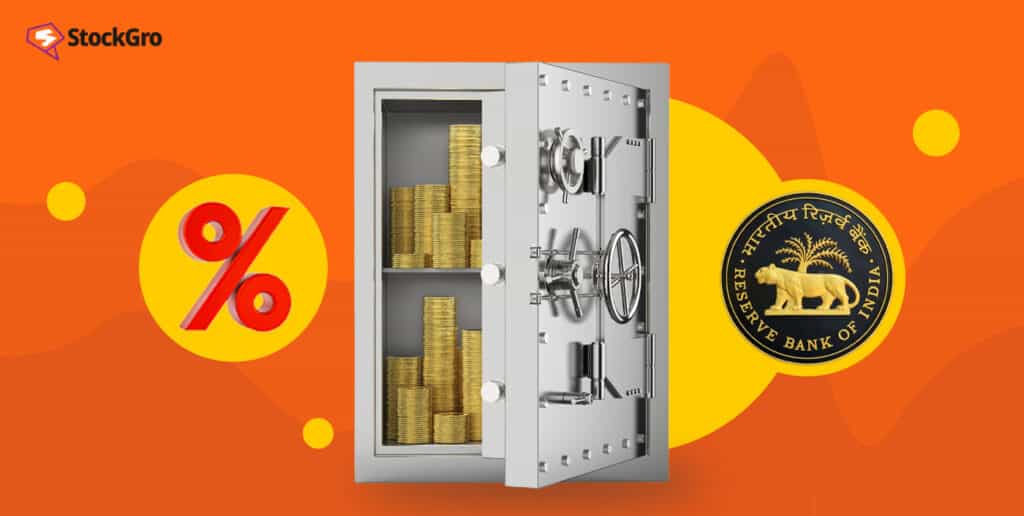
A government may intervene in the financial affairs of its country from time to time to regulate the economy and prevent economic extremities of any kind. To do so, the government may have regulatory tools and procedures with important financial bodies like banks. CRR (Cash Reserve Ratio) is one of the tools the government uses to exercise control over the economy.
Let’s delve into the details of CRR – its purpose and impact on the economy.
What is CRR?
CRR stands for Cash Reserve Ratio. Every bank has deposits from its customers and it is statutorily required by the Reserve Bank of India (RBI) to maintain a certain percentage of these deposits as cash with the RBI.
The CRR is a rate that is announced by the RBI, determining the percentage of deposits that banks need to maintain as cash. Here, the cash reserve is deposited to the RBI. These deposits can not be utilised for lending, investment, or other purposes. The current CRR is 4.5%.
Purpose of CRR
CRR mainly serves two purposes:
- Safety: CRR acts as a safety blanket against sudden liquidity crunches or other emergencies. Since the RBI does not invest the funds anywhere and is readily available, it is a secure reserve for banks.
- Tool to control money supply in the economy: CRR is an essential tool in the government’s monetary policy toolkit. The level of money supply available in the economy is controlled using monetary policy.
You may also like: RBI MPC meeting: Repo rate unchanged, what does it mean for you?
How do banks maintain CRR?
Every bank has a cash reserve ratio account that they maintain with the RBI and replenish with cash as required.
The bank calculates the requirement as a percentage of its Net Demand and Time Liabilities (NDTL). NDTL comprises various deposits, such as fixed deposits, savings bank deposits, recurring deposits, and others.
For instance, if a bank has Rs.1,000 crores of NDTL and the CRR is at 4.50%, then the bank is obligated to deposit at least Rs.45 crores with the RBI.
How does the CRR affect the economy?
As mentioned earlier, CRR is used to intervene and control the level of money supply in the economy. So how does the government use CRR to control the money supply, and why does it need to do so?
Let us understand this with the help of an example.
Consider a situation where inflation is high in the economy. In July 2023, India’s retail inflation surged to a 15-month high of 7.44% from 4.81% in June 2023. In this situation, the government will want to reduce the amount of money in the hands of people so that spending goes down. A fall in demand will follow this, which will lead to a fall in the prices of goods and services, i.e. lower inflation.
To reduce liquidity in the economy, the best way is to target the citizens’ source of liquidity, i.e. banks. When the CRR increases, the banks will be required to deposit a higher percentage of their deposits with the RBI for safekeeping.
This means the bank has a relatively lower amount of money to lend to customers. Lower funds mean banks must increase lending rates, causing fewer borrowers. This eventually translates into lower liquidity in the economy and has the desired effect of reduced inflation.
Similarly, if the government wants to boost spending, it will reduce the CRR, eventually increasing the level of demand.
Also Read: Mastering revenue expenditure – Categories, impacts and management
Current CRR news
Currently, the CRR rate is at 4.50% as of 17th August 2023. The previous CRR was 4.00% and in May 2023, the RBI hiked it by 50 basis points (or 0.50%) as a measure to control inflation in the economy.
In response to 24/7 banking operations, the RBI plans to adjust the CRR computation time to closer to midnight, preventing excess deposits and encouraging lending and investing. This change will help to stable bank interest rates, handling recent fluctuations (rates surged overnight) despite ample liquidity within banks.
Difference between CRR and SLR
Statutory Liquid Ratio (SLR), like CRR, is another monetary policy tool that the government deploys through banks.
The key differences between CRR and SLR have been highlighted in the table below:
| Point of Difference | Cash Reserve ratio | Statutory Liquid Ratio |
| Meaning | The CRR is a rate that is announced by the RBI and determines the percentage of bank deposits that need to be maintained as cash with the RBI. | The SLR is a rate declared by the RBI which entails the minimum percentage of deposits that a bank must maintain with itself in the form of liquid assets like cash, gold and other RBI-approved securities. |
| Interest Earned | The banks do not earn any interest on the amount that they deposit in their CRR account. | The banks earn interest on their SLR deposits. |
| Purpose | Mainly to control the level of liquidity and as a safe reserve held with the RBI. | To control the level of liquidity, leverage credit expansion and ensure the solvency of banks. |
| Current Rate | 4.50% | 18.00% |
| Deposited With | The RBI | The bank itself |
Bottom line
In short, the cash reserve ratio is the minimum amount of cash banks are statutorily required to maintain with the central bank. It is an important monetary policy tool for the government.
Also Read: EBITDA explained: Definition, calculation, significance, and more
As a bank customer, it is crucial to understand how CRR affects the lending and borrowing rates of banks as it can help you make more informed decisions while making deposits/borrowing from banks.

